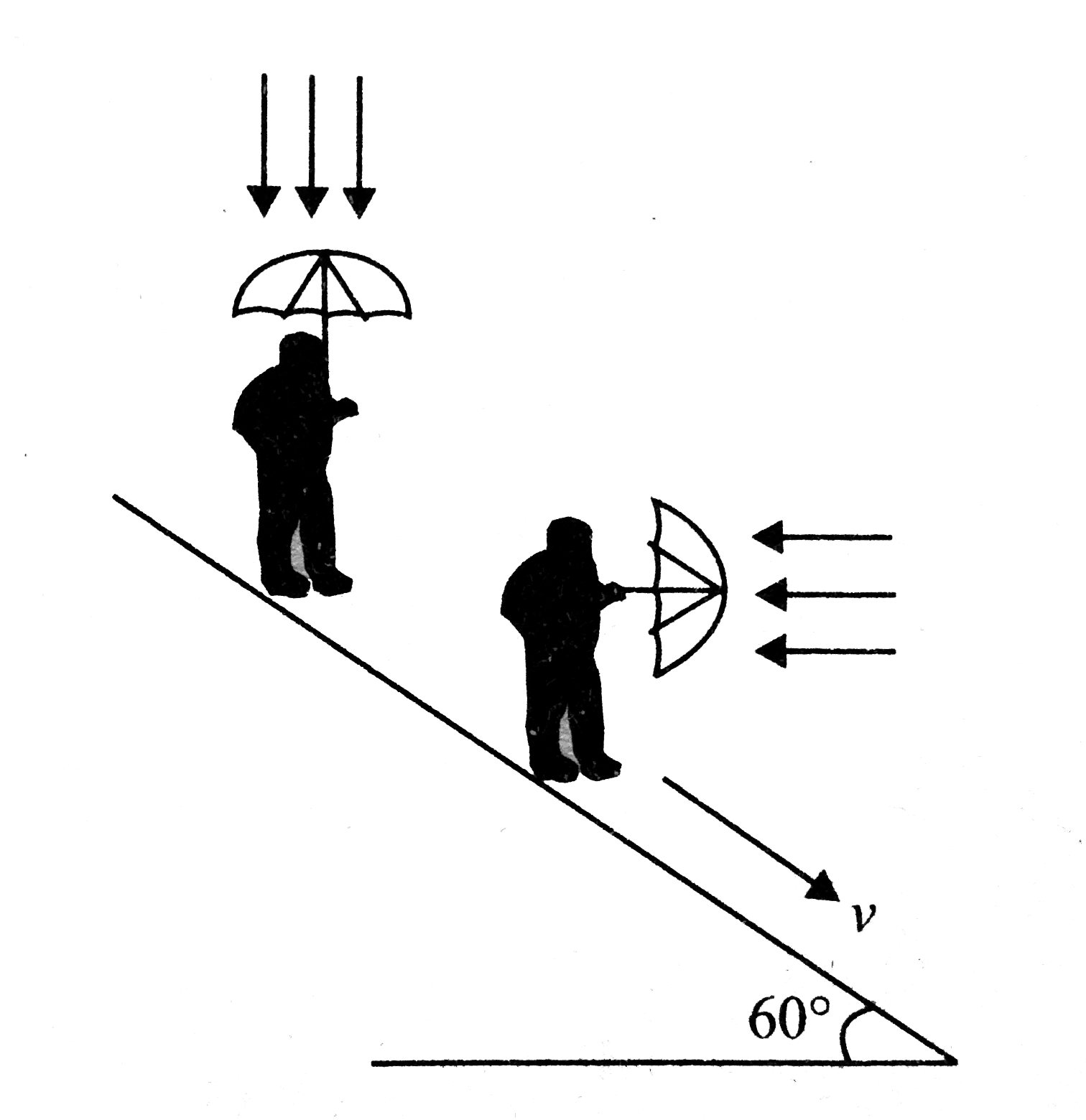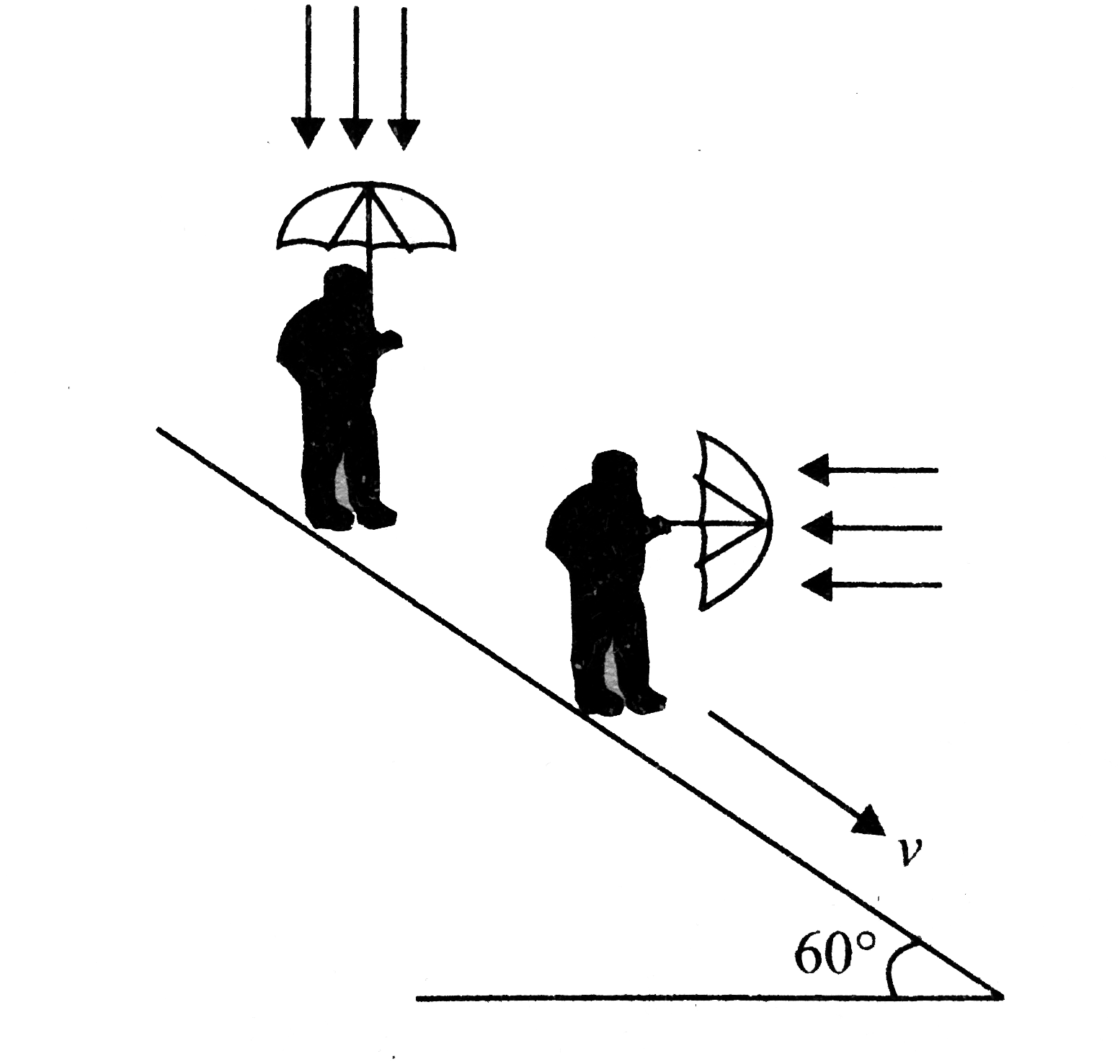A man running at a speed of 5 km/h finds that the rain is falling vertically. When the stops running, the finds that the rain is falling at an angle of 60∘ with the horizontal. The velocity of rain with respect to running man is
5√3 km/h
5√32 km/h
4√35 km/h
5√3 km/h
The correct Answer is:D
To solve the problem step by step, we will analyze the situation using relative velocity concepts.
Step 1: Understand the scenario
The man is running at a speed of 5 km/h. When he is running, he perceives the rain to be falling vertically. When he stops, he sees the rain falling at an angle of 60 degrees with the horizontal.
Step 2: Define the velocities
Let:
- Vm=5 km/h (velocity of the man)
- Vr = velocity of the rain (unknown)
- When the man is running, the rain appears to fall vertically, which means the horizontal component of the rain's velocity must equal the man's speed.
Step 3: Analyze the situation when the man is running
When the man is running, the rain appears to fall vertically. This means that the horizontal component of the rain's velocity is equal to the man's speed:
Vrcos(60∘)=Vm
Since cos(60∘)=12:
Vr⋅12=5
Vr=10 km/h
Step 4: Analyze the situation when the man stops
When the man stops, the rain is falling at an angle of 60 degrees with the horizontal. We can use the tangent of the angle to find the relationship between the vertical and horizontal components of the rain's velocity:
tan(60∘)=Vrsin(60∘)Vrcos(60∘)
Since tan(60∘)=√3:
√3=Vr⋅√32Vr⋅12
This simplifies to:
√3=√31
This confirms that the angle is consistent with the velocities.
Step 5: Calculate the relative velocity of rain with respect to the man
Now we can find the relative velocity of the rain with respect to the man using the formula:
Vrm=√V2r+V2m−2VrVmcos(60∘)
Substituting the known values:
Vrm=√(10)2+(5)2−2⋅10⋅5⋅12
=√100+25−50
=√75
=5√3 km/h
Final Answer
The velocity of the rain with respect to the running man is 5√3 km/h.
---
The man is running at a speed of 5 km/h. When he is running, he perceives the rain to be falling vertically. When he stops, he sees the rain falling at an angle of 60 degrees with the horizontal.
Let:
- Vm=5 km/h (velocity of the man)
- Vr = velocity of the rain (unknown)
- When the man is running, the rain appears to fall vertically, which means the horizontal component of the rain's velocity must equal the man's speed.
When the man is running, the rain appears to fall vertically. This means that the horizontal component of the rain's velocity is equal to the man's speed:
Vrcos(60∘)=Vm
Since cos(60∘)=12:
Vr⋅12=5
Vr=10 km/h
When the man stops, the rain is falling at an angle of 60 degrees with the horizontal. We can use the tangent of the angle to find the relationship between the vertical and horizontal components of the rain's velocity:
tan(60∘)=Vrsin(60∘)Vrcos(60∘)
Since tan(60∘)=√3:
√3=Vr⋅√32Vr⋅12
This simplifies to:
√3=√31
This confirms that the angle is consistent with the velocities.
Now we can find the relative velocity of the rain with respect to the man using the formula:
Vrm=√V2r+V2m−2VrVmcos(60∘)
Substituting the known values:
Vrm=√(10)2+(5)2−2⋅10⋅5⋅12
=√100+25−50
=√75
=5√3 km/h
The velocity of the rain with respect to the running man is 5√3 km/h.
Similar Questions
A man starts running along a straight road with uniform velocity observes that the rain is falling vertically downward. If he doubles his speed, he finds that the rain is coming at an angle θ to the vertical. The velocity of rain with respect to the ground is :
View SolutionA man starts running along a straight road with uniform velocity observes that the rain is falling vertically downward. If he doubles his speed, he finds that the rain is coming at an angle θ to the vertical. The velocity of rain with respect to the ground is :
View SolutionA stationary man observes that the rain is falling vertically downwards. When he starts running a velocity of 12kmh−1, he observes that the rain is falling at an angle 60∘ with the vertical. The actual velocity of rain is
View SolutionA man walking with a speed of 3 km/h finds the rain drops falling vertically downwards. When the man increases his speed to 6km/h he find that the rain drops are falling making an angle of 30∘ with the vertical . Find the speed of the rain drops ( in km/h)
View SolutionA person walking ,on a horizontal road at 2 km/h finds that the rain is falling vertically . Now the person increasses his speed to 4 km/h and find that rain makes an angle 45∘ with the vertical . Find the velocity of rain with respect to the road.
View SolutionA man standing on a inclined plain observes rain is falling vertically. When he starts moving down the inclined plain with velocity v=6m/s observes rain hitting him horizontally.

The velocity of rain with respect to the man when he is moving down is
View SolutionWhen a man moves down the inclined plane with a constant speed 5ms−1 which makes an angle of 37∘ with the horizontal, he finds that the rain is falling vertically downward. When he moves up the same inclined plane with the same speed, he finds that the rain makes an angle θ=tan−1(78) with the horizontal. The speed of the rain is
View SolutionTo a man walking at the rate of 4 km/h the rain appears to fall vertically. When he increases his speed 8 km/h it appears to meet him at an angle of 45 with vertical. Find the angle made by the velocity of rain with the vertical and its value.
View SolutionA man is running up an inclined plane ( making an angle θ with the horizontal ) with a speed u. Rain drops falling at an angle α with the vertical appear to the man as if they are falling at an angle of 45∘ with the horizontal . The speed of the rain drops is
View SolutionA man standing on a inclined plain observes rain is falling verticaly. When he starts moving down the inclined plain with velocity v=6m/s observes rain hitting him horizontally.

The actual velocity of rain is
View Solution
